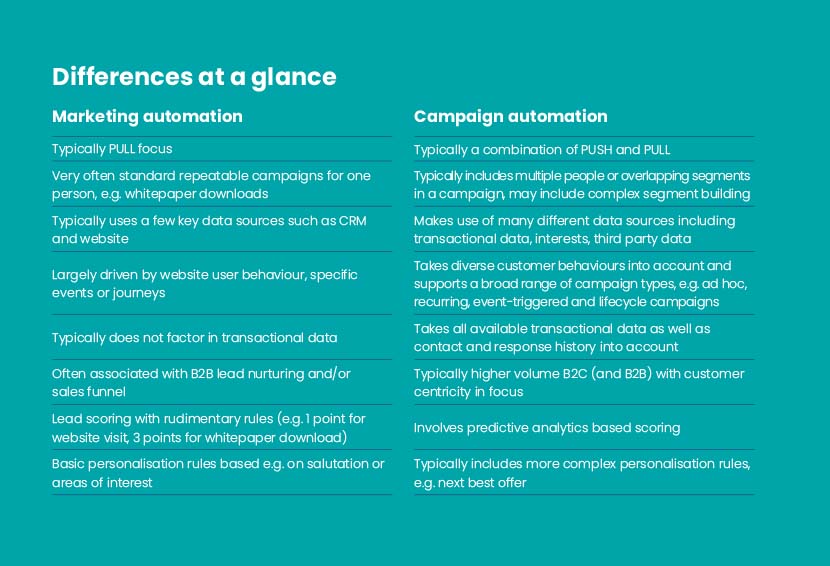Should you use marketing automation or campaign automation? 8 key differences to know before doing your research


Find out which works better for your organisation.
When marketers want to improve the efficiency of their marketing activities, they often turn to marketing automation – a term coined by mainly large American software companies. What’s more, the term ‘campaign automation’ is often taken to mean the same thing.
This blog explains the actual differences between these two common terms. We’ll also share why campaign automation may be the better and more sophisticated choice for marketers (depending on their exact use case requirements).
Defining marketing and campaign automation
How is campaign automation different from marketing automation?
Let’s start with a definition of the two terms:
Marketing automation is a category of technology that allows companies to streamline, automate, and measure marketing tasks and workflows. The intended goal of marketing automation is to improve your company’s operational efficiency and hopefully grow revenue faster. An example would be an automated confirmation email when someone fills in a form to download a free eBook or makes a purchase.
Campaign automation is the use of an omnichannel software platform to consolidate, create, and automate a variety of related marketing initiatives. It incorporates customer data analysis and complex targeting rules and gives companies the ability to fully automate the end-to-end campaign process, both online and offline.
What does this mean in practice? There are eight key differences.

1. Push vs. pull focus
Push and pull marketing are two principles that guide marketing strategies. Push marketing is about bringing your brand and offers in front of your target audience (for example, through paid advertisements). On the other hand, pull marketing focuses on creating a demand that naturally draws consumers to your offerings. In this context, the terms inbound and outbound marketing are also often mentioned.
Due to its reactive nature, marketing automation typically has a stronger pull focus and is often related to inbound content marketing led initiatives. Standard examples of marketing automation in practice include automatically triggered emails when someone abandons a basket, signs up to a newsletter or downloads an eBook. As you can see here, marketing automation tends to follow an action initiated by the customer.
Campaign automation, in contrast, combines both pull and push approaches. It can handle consumer-initiated triggers, but it can also automatically send personalised offers to people who are part of a specific segment or have recently purchased and are now reminded of their next purchase (Best Next Time). They may also be a part of lifecycle campaigns (welcome, reactivation, at risk of churn, etc.).
2. One person vs. segments
Another differentiator is that marketing automation often uses standard repeatable campaigns that include one person at a time. This could, for example, be a campaign that follows up on the download of an eBook and presents other eBooks or case studies to the prospect – matching his or her interests. However, every person included in this eBook download campaign will receive the same messaging.
Campaign automation is different. Instead of including just one person per campaign broadcast, the audience for a campaign is defined by an individual’s affiliation to a certain segment. Hence, a campaign broadcast can include multiple people who are part of a specific segment. Segment building can range from reflecting simple measures, such as geographic or sociodemographic aspects, to complex segmentation building rules based on consumer behaviour, such as buying frequency or customer lifetime value. Due to the overlapping nature of segments (one person can be in multiple segments), complex audience and deduplication rules may apply.

3. Few vs. many data sources
The third difference is the kind of data sources that marketing and campaign automation use. Marketing automation typically uses a few key data sources, such as CRM and website analysis data. In contrast, campaign automation uses many different data sources from many diverse channels. This includes CRM and website data, and it also includes transactional data (e.g. when someone has bought something and for what amount), individual interests and preferences, and third-party data. It is not untypical to have five or more data sources feeding into campaign automation.
4. Website vs. other behavioural data
Closely linked to the data sources being used, marketing automation is largely driven by website user behaviour and specific events and journeys that happen on a website. Things like: where someone clicked, what pages they visited, which items they put in their online basket, whether they signed up for something, and so on.
Campaign automation takes into account diverse customer behaviours across different channels, and supports a broad range of campaign types like ad hoc, recurring, event-triggered and lifecycle campaigns. This means that campaign automation can, for example, reflect whether someone’s lifecycle stage has changed, e.g. from being an active customer to being an inactive customer.
5. Non-transactional vs. transactional data
Transactional data provides information on what products were purchased, the average order value, plus how often and when someone buys. Using this information offers great potential for personalisation. However, marketing automation typically doesn’t factor in deep or diverse transactional data.
Campaign automation, however, makes use of this data and supports tactics such as next best offer or next best time calculations on an individual basis. Additionally, campaign automation also reflects the previous channel, contact and response history. In practice, this means that future communications can be optimised based on which communications someone has already received and their past response. For example, individuals can be excluded from certain future communications to avoid over-communication (i.e. frequency capping). Doing this allows for the monitoring of interactions across several channels in a temporal context, such as whether someone has opened an email newsletter, clicked on a social ad, and then used a voucher code delivered via direct mail. This facilitates customer journey analyses.

6. B2B vs. B2C context
Marketing automation is often associated with B2B lead nurturing and/or sales funnel activities. In practice, this means that marketing automation workflows are mostly used to score the quality of incoming leads and further qualify them into marketing or sales qualified leads, often for smaller volumes of customers.
Campaign automation is mostly used in a B2C context, but it can be used in a B2B context as well. Overall, it deals with higher volumes of customer data and potentially very high volumes of associated transactional data. It aims to foster customer-centricity and customer retention by providing personalised and engaging customer communications.
7. Basic vs. complex scoring rules
To qualify leads, marketing automation systems often use basic scoring mechanisms. For example, one point is assigned for a website visit, three points for a whitepaper download, five points for a newsletter sign-up etc. Once a lead has passed a certain benchmark, it is considered relevant by the business.
In addition to these basic rules, campaign automation also uses predictive analytics scoring. This means that behavioural patterns can be analysed within a group of customers who have purchased a certain item in the past. These behavioural patterns are then identified within other customers, and based on how similar their behaviour is, a score is assigned to them (so-called lookalike profiling). The higher the score, the more similar the behaviour. This knowledge can then be used to influence those customers towards a desired outcome, such as purchasing a certain item.
8. Basic vs. complex personalisation rules
As a result of the differences outlined previously, marketing automation and campaign automation offer different levels of personalisation. Whereas marketing automation often follows rather basic personalisation rules – such as personalisation based on salutation and areas of interest – campaign automation uses more complex personalisation rules. These include highly personalised offers based on previous purchases – or even a next best offer based on a comparison across all customer purchases. Other rules may include an individual’s preferred contact channel, personalised send times, and personalised discounts, to name just a few examples.
Marketing automation’s more sophisticated cousin
To conclude, marketing automation can automate manual routine tasks and increase the efficiency of these activities by saving time.
However, campaign automation is more complex and refined in many ways – in other words, it could be considered marketing automation’s more sophisticated cousin. Overall, it allows for the intelligent automation of marketing activities, which not only increases its efficiency but also its effectiveness by enabling powerful targeting, personalised content, send times, and omnichannel activities.
The following table provides you with a quick overview of the differences outlined before:

If you'd like to learn more about campaign automation and how to benefit from it, get in touch with Apteco
Want more like this?
Want more like this?
Insight delivered to your inbox
Keep up to date with our free email. Hand picked whitepapers and posts from our blog, as well as exclusive videos and webinar invitations keep our Users one step ahead.
By clicking 'SIGN UP', you agree to our Terms of Use and Privacy Policy


By clicking 'SIGN UP', you agree to our Terms of Use and Privacy Policy
Other content you may be interested in
Categories
Categories
Categories

Want more like this?


Want more like this?
Insight delivered to your inbox
Keep up to date with our free email. Hand picked whitepapers and posts from our blog, as well as exclusive videos and webinar invitations keep our Users one step ahead.
By clicking 'SIGN UP', you agree to our Terms of Use and Privacy Policy









